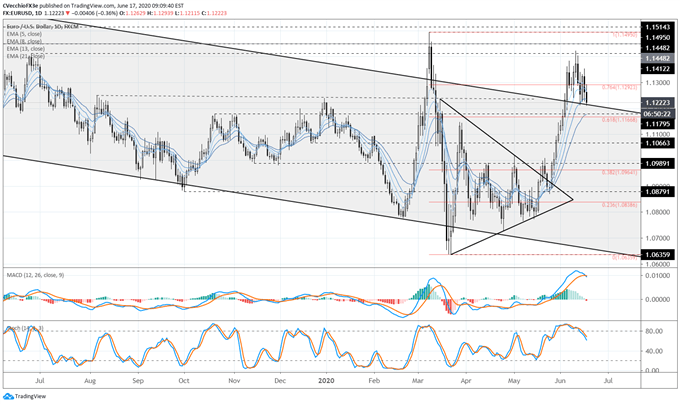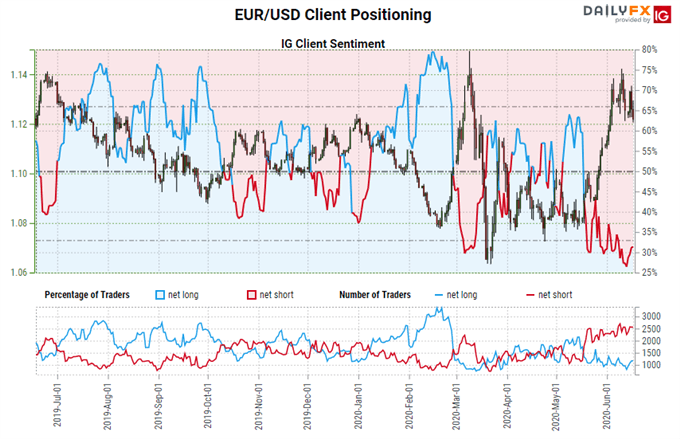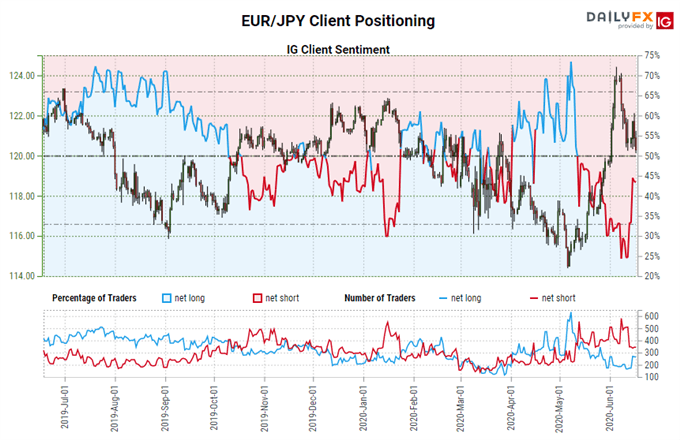EUR/USD, EUR/JPY Rallies Infeebled By Virus Headlines - Key Levels
Euro Rally Takes a Breather
The Euro was the best performing currency during the last two weeks of May and the first two weeks of June. While those European countries hit with the pandemic first have flattened the curve, so to speak, the ignition of a second wave in China coupled with evidence that the United States never beat its first wave suggests that global growth is going to struggle. And that may mean prospects around the European growth picture aren’t as rosy. Fresh concerns about a fresh wave of coronavirus infections in developed economies has undercut the otherwise bullish narrative around the Euro and the recent signals towards fiscal union.
Eurobonds are a Gamechanger Towards Fiscal Union
It seems a lesson may have been learned from the 2010 Eurozone debt crisis: France and Germany have come forth with a €500 billion proposal for an emergency fund, fully backed by debt issued by the EU. The EU Commission has trumped that proposal, setting forth a goal of €750 billion. And so while the recovery fund still needs to be ratified by each of the 27 member nation’s legislative bodies, we are now on the path to federalized debt in Europe.
Unlike in 2010, when the Southern periphery countries went forward to the Northern core countries asking for jointly issued debt and the Northern core countries said no, this time they might have said yes. And so Europe, at a time when there’s a chance to work together, is finally action as a union.
Significant Progress Made, Waiting for Implementation
Consider this. One of the running themes since The Great Recession has been that G10 central banks have been ‘the only game in town,’ in the words of Mohammed El-Erian. Because central banks have been so aggressive with their easing measures, the onus has been removed from fiscal policymakers to legislate long-term solutions to systemic economic woes. So while Draghi’s “whatever it takes” moment was good for the Euro in the short-term, staving off ruin, it ultimately removed pressure from politicians to reform their economies.
As paradoxical as it may sound, ECB President Lagarde’s comment that “we’re not here to narrow spreads” – a suggestion that it wasn’t the ECB’s job to reduce sovereign credit risk in the periphery relative to the core – may have been one of the sparks that ignited Germany to embrace jointly-issued debt.
But that doesn’t mean we’re out of the woods just yet. The backdrop and tone of the global economy and the European political environment remains unfriendly towards the EU’s long-term prospects, and could quickly erode if the Northern core countries prove unwilling to share economic burdens with the less fiscally stable countries in the Southern periphery.
Now that we’re in the purgatory period – promises have been made, but no implementation yet – the Euro is once again proving vulnerable to the speculative flows around the coronavirus pandemic.
EUR/USD RATE TECHNICAL ANALYSIS: DAILY CHART (June 2019 to June 2020) (CHART 1)

EUR/USD rates may be signaling a near-term end to the sharp rally that took hold starting on May 18, when the first iteration of the German-French Eurozone recovery fund was announced. The symmetrical triangle breakout yielded a move through the descending channel in place since May 2018, the second such occurrence this year (a failed bullish breakout in early-March).
But it now appears that a second failed breakout attempt may be transpiring. EUR/USD rates have started to slip through their EMA envelope to the downside, last spotted trading below the daily 13-EMA (note: the daily 5-, 8-, 13-, and 21-EMA envelope is turning lower, but is not in bearish sequential order). To this end, a move below 1.1215 would suggest that EUR/USD rates have returned back into the 25-month downtrend.
Losses through 1.1215 would constitute a false bullish breakout from the downtrend, setting up for a drop lower towards the 61.8% retracement and 50% retracement of the 2020 high/low range at 1.1167 and 1.1066, respectively.
IG Client Sentiment Index: EUR/USD Rate Forecast (June 17, 2020) (Chart 2)

EUR/USD: Retail trader data shows 30.65% of traders are net-long with the ratio of traders short to long at 2.26 to 1. The number of traders net-long is 4.97% lower than yesterday and 5.87% lower from last week, while the number of traders net-short is 0.41% lower than yesterday and 2.08% lower from last week.
We typically take a contrarian view to crowd sentiment, and the fact traders are net-short suggests EUR/USD prices may continue to rise.
Traders are further net-short than yesterday and last week, and the combination of current sentiment and recent changes gives us a stronger EUR/USD-bullish contrarian trading bias.
EUR/JPY RATE TECHNICAL ANALYSIS: DAILY CHART (June 2019 to June 2020) (CHART 3)

Like EUR/USD rates, EUR/JPY rates are exhibiting signs of failure in the context of a false bullish breakout. The symmetrical triangle reversal and breakout higher away from the yearly lows saw EUR/JPY rates rally back into the rising trendline from September 2012, June 2016, and January 2019 lows. But like attempts made in December 2019 and January 2020, EUR/JPY rates have failed once more; in the form of an evening star candle cluster, this was, in hindsight, the sign of a clear top.
To this end, the neutral doji candle formed on June 12 carved out a range between 120.25 and 121.82, with tests on both sides in recent days. But the doji range has formed below the falling trendline from the 2018 swing highs, suggesting that the false breakout narrative is confirmed. To this end, a drop below 120.25 appears to be favored, particularly as momentum indicators (Slow Stochastics, daily MACD) turn lower, and will gain credibility should the daily 21-EMA break (currently 120.34).
IG Client Sentiment Index: EUR/JPY Rate Forecast (June 17, 2020) (Chart 4)

EUR/JPY: Retail trader data shows 45.00% of traders are net-long with the ratio of traders short to long at 1.22 to 1. The number of traders net-long is 8.05% lower than yesterday and 28.02% higher from last week, while the number of traders net-short is 5.52% higher than yesterday and 38.58% lower from last week.
We typically take a contrarian view to crowd sentiment, and the fact traders are net-short suggests EUR/JPY prices may continue to rise.
Positioning is more net-short than yesterday but less net-short from last week. The combination of current sentiment and recent changes gives us a further mixed EUR/JPY trading bias.
Comments
 No Thumbs up yet!
No Thumbs up yet!



